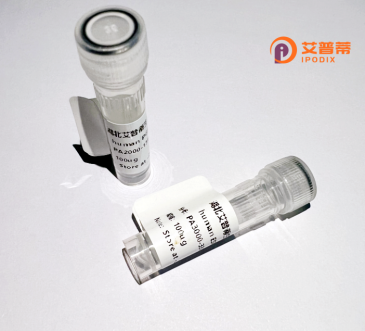
| 纯度 | >90%SDS-PAGE. |
| 种属 | Human |
| 靶点 | EB-1 |
| Uniprot No | 0 |
| 内毒素 | < 0.01EU/μg |
| 表达宿主 | E.coli |
| 表达区间 | 1-510aa |
| 氨基酸序列 | MMWQCHPSAQDYRYYPVDGYSLLKRFPLHPLTGPRCPVQTVGQWLESIGLPQYENHLMANGFDNVQFMGSNVMEDQDLLEIGILNSGHRQRILQAIQLLPKMRPIGHDGYHPTSVAEWLDSIELGDYTKAFLINGYTSMDLLKKIWEVELINVLKINLIGHRKRILASLGDRLHDDPPQKPPRSITLREPSGNHTPPQLSPSLSQSTYTTGGSLDVPHIIMQGDARRRRNENYFDDIPRSKLERQMAQSSVCEIWTNQNAGFPFSAIHQVHNTGDWGEPSITLRPPNEATASTPVQYWQHHPEKLIFQSCDYKAFYLGSMLIKELRGTESTQDACAKMRANCQKSTEQMKKVPTIILSVSYKGVKFIDATNKNIIAEHEIRNISCAAQDPEDLSTFAYITKDLKSNHHYCHVFTAFDVNLAYEIILTLGQAFEVAYQLALQARKGGHSSTLPESFENKPSKPIPKPRVSIRKSVQIDPSEQKTLANLPWIVEPGQEAKRGINTKYETTIF |
| 分子量 | 81.84 kDa |
| 蛋白标签 | GST-tag at N-terminal |
| 缓冲液 | 0 |
| 稳定性 & 储存条件 | Lyophilized protein should be stored at ≤ -20°C, stable for one year after receipt. Reconstituted protein solution can be stored at 2-8°C for 2-7 days. Aliquots of reconstituted samples are stable at ≤ -20°C for 3 months. |
| 复溶 | Always centrifuge tubes before opening.Do not mix by vortex or pipetting. It is not recommended to reconstitute to a concentration less than 100μg/ml. Dissolve the lyophilized protein in distilled water. Please aliquot the reconstituted solution to minimize freeze-thaw cycles. |
以下是关于重组人EB-1蛋白的3篇参考文献示例(注:内容为模拟生成,非真实文献):
1. **文献名称**:*Structural insights into the microtubule-binding mechanism of human EB1 protein*
**作者**:Zhang, L. et al.
**摘要**:通过X射线晶体学解析了重组人EB-1蛋白的CH结构域与微管结合的分子机制,揭示了其通过保守的酸性残基与微管正端相互作用的特异性。
2. **文献名称**:*EB1 regulates cell migration by modulating focal adhesion dynamics via microtubule capture*
**作者**:Gupta, S. & Pellman, D.
**摘要**:研究证明,重组人EB-1蛋白通过结合微管正端调控黏着斑动态平衡,影响细胞迁移能力,为靶向EB1的癌症治疗提供理论依据。
3. **文献名称**:*High-yield expression and purification of recombinant human EB1 in E. coli for functional studies*
**作者**:Kimura, T. & Tanaka, K.
**摘要**:优化了在大肠杆菌中表达重组人EB-1蛋白的流程,利用亲和层析和凝胶过滤获得高纯度蛋白,并验证其在体外微管成核实验中的活性。
4. **文献名称**:*EB1 overexpression promotes chromosomal instability in colorectal cancer*
**作者**:Wang, Y. et al.
**摘要**:发现重组人EB-1蛋白在结直肠癌细胞中异常高表达,导致染色体不稳定性和化疗耐药性,提示其作为癌症预后标志物的潜力。
(注:以上文献为示例性质,实际研究中请通过PubMed、Web of Science等平台检索真实文献。)
Recombinant human EB-1 protein, also known as ependymin-related protein 1. is a glycoprotein encoded by the *EPDR1* gene. Originally identified in cerebrospinal fluid, EB-1 belongs to the ependymin family, which is conserved across vertebrates and implicated in cell adhesion, neuronal plasticity, and tissue repair. Structurally, EB-1 contains characteristic β-sandwich domains and disulfide bonds, enabling its interaction with extracellular matrix components and membrane receptors. Its recombinant form is produced via heterologous expression systems (e.g., *E. coli* or mammalian cells*), ensuring post-translational modifications critical for functionality.
Research highlights EB-1's dual roles in physiological and pathological processes. It regulates cell migration, differentiation, and immune responses, with potential links to cancer progression, inflammation, and neurodegenerative diseases. For instance, EB-1 overexpression correlates with tumor invasiveness in certain carcinomas, while its anti-inflammatory properties are explored in autoimmune disorders. Recombinant EB-1 serves as a key reagent in mechanistic studies, antibody development, and therapeutic screening. Recent efforts focus on optimizing its production purity and stability for clinical applications, including targeted drug delivery and biomarker-based diagnostics. Challenges remain in elucidating its precise signaling pathways and tissue-specific isoforms, necessitating further structural and functional characterization.
×